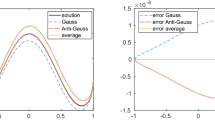Abstract
In this paper a new modified Nyström method is proposed to solve linear integral equations of the second kind with fixed singularities of Mellin convolution type. It is based on the Gauss–Radau quadrature formula with a suitable Jacobi weight. The stability and convergence of the method is proved in weighted spaces with uniform norm. Moreover, an error estimate of the numerical solution is given under certain assumptions on the Mellin kernel. The efficiency of the method is shown through some examples. The numerical results also confirm that the error estimate is sharp.
Similar content being viewed by others
References
Atkinson, K.E.: The Numerical Solution of Integral Equations of the Second Kind, Cambridge Monographs on Applied and Computational Mathematics, vol. 552. Cambridge University Press, Cambridge (1997)
De Bonis, M.C., Laurita, C.: A modified Nyström method for integral equations with Mellin type kernels. J. Comp. Appl. Math. 296, 512–527 (2016)
De Bonis, M.C., Laurita, C.: A Nyström method for integral equations with fixed singularities of Mellin type in weighted \({L}^p\) spaces. Appl. Math. Comput. 303, 55–69 (2017)
De Bonis, M.C., Laurita, C.: On the stability of a modified Nyström method for Mellin convolution equations in weighted spaces. Numer. Algorithms 79, 611–631 (2018)
Elliott, D., Prössdorf, S.: An algorithm for the approximate solution of integral equations of Mellin type. Numer. Math. 70, 427–452 (1995)
Elschner, J.: On spline approximation for a class of non-compact integral equations. Math. Nachr. 146, 271–321 (1990)
Elschner, J.: The \(h-p-\)version of spline approximation methods for Mellin convolution equations. J. Integr. Eq. Appl. 5, 47–73 (1993)
Elschner, J., Graham, I.G.: Numerical methods for integral equations of Mellin type. J. Comp. Appl. Math. 125, 423–437 (2000)
Kress, R.: Linear Integral Equations, Applied Mathematical Sciences, vol. 82. Springer, Berlin (1989)
Kress, R.: A Nyström method for boundary integral equations in domains with corners. Numer. Math. 58, 445–461 (1990)
Laurita, C.: A numerical method for the solution of integral equations of Mellin type. Appl. Numer. Math. 116, 215–229 (2017)
Mastroianni, G., Milovanovic, G.V.: Interpolation Processes Basic Theory and Applications. Springer Monographs in Mathematics. Springer, Berlin (2009)
Mastroianni, G., Monegato, G.: Nyström interpolants based on the zeros of Legendre polynomials for a non-compact integral operator equation. IMA J. Numer. Anal. 14, 81–95 (1993)
Mastroianni, G., Russo, M.G.: Lagrange interpolation in weighted Besov spaces. Constr. Approx. 15, 257–289 (1999)
Monegato, G.: A stable Nyström interpolant for some Mellin convolution equations. Numer. Algorithms 11, 271–283 (1996)
Nevai, G.P.: Mean convergence of Lagrange interpolation. I. J. Approx. Theory 18, 363–377 (1976)
Nevai, G.P.: Orthogonal Polynomials. American Mathematical Society, Providence, R.I. (1979)
Nevai, G.P.: Mean convergence of Lagrange interpolation. III. Trans. Am. Math. Soc. 282, 669–698 (1984)
Szegő, G.: Orthogonal polynomials, American Mathematical Society Colloquium Publications, vol. 23, 4th edn. American Mathematical Society, Providence (1975)
Acknowledgements
The author is partially supported by INdAM-GNCS 2019 project “Discretizzazione di misure, approssimazione di operatori integrali ed applicazioni” and by University of Basilicata (local funds). The author is member of the INdAM Research group GNCS. This research has been accomplished within the RITA “Research ITalian network on Approximation”.
Author information
Authors and Affiliations
Corresponding author
Additional information
Publisher's Note
Springer Nature remains neutral with regard to jurisdictional claims in published maps and institutional affiliations.
Appendix
Appendix
In this section we will give some estimates for the quadrature error of the Gauss–Radau formula with respect to a Jacobi weight \(v^{\alpha ,\beta }(x)\), \(\alpha ,\beta >-1\),
Now, we recall some useful notation and definitions.
For a function \(F \in C\), by \(E_n(F)_{\infty }\) we denote the error of best polynomial approximation
where \(\mathbb {P}_n\) is the set of all algebraic polynomials on [0, 1] of degree at most n.
Taking into account that the algebraic degree of exactness of the formula (41) is \(2n-2\), by classical arguments (see, for instance, [12, Theorem 5.1.6]) it can be proved the following
Theorem 8
For any \(F \in C\), the estimate
holds true.
For a general weight function w(x) on [0, 1] and \(1\le p<+\infty \), we denote by \(L^p_{w}\), the weighted space of all real-valued measurable functions F on [0, 1] such that
Moreover, we consider the following weighted Sobolev type subspaces of \(L^p_{w}\)
where r is a positive integer, \(\varphi (x)=\sqrt{x(1-x)}\) and AC(0, 1) denotes the collection of all functions which are absolutely continuous on every closed subset of (0, 1), endowed with the norm
Let us denote by
the error of weighted best approximation of the function \(F\in L^p_{w}\) by means of polynomials of degree at most n. For functions F belonging to \(W_r^p(w)\), the following Favard inequality
holds true for a constant \({{\mathcal {C}}}\ne {{\mathcal {C}}}(n,F)\) (see, for example, [12, (2.5.22), p. 172]). Iterating this inequality, one gets the estimate
We need the following auxiliary result.
Lemma 3
The knots and weights of the quadrature formula (41) satisfy the following conditions
and
where \(\varDelta x_{n,i}=x_{n,i+1}-x_{n,i}\), \(i=1,\ldots ,n-1\) and \({{\mathcal {C}}}\ne {{\mathcal {C}}}(n)\).
Proof
We recall that the nodes of the quadrature rule (41) are \(x_{n,1}=0\) and \(x_{n,2},\ldots ,x_{n,n}\) the zeros of the Jacobi polynomial
orthonormal with respect to the weight \(v^{\alpha ,\beta +1}(x)=(1-x)^{\alpha }x^{\beta +1}\) on the interval [0, 1]. Denoting by \(l_{n,i}(x)\), \(i=1,\ldots ,n\), the fundamental Lagrange polynomials based on the system of knots \(\{x_{n,1},\ldots ,x_{n,n} \}\), for the coefficients of the quadrature formula (41) we can write
Taking into account that
we have
and
Then, for \(i=2,\ldots ,n-1\), one has that (see [16])
from which, since
and
(see, for instance, [12]), we have
It remains to prove (44). To this end, starting from (45), we rewrite the coefficient \(\lambda _{n,1}\) as
In what follows we will denote by \(x_{n-1,i}^{\alpha ,\beta +1}\) and \(\lambda _{n-1,i}^{\alpha ,\beta +1}\), \(i=1,\ldots ,n-1\), the nodes and coefficients of the \((n-1)\)–point Gaussian quadrature formula on [0, 1] w.r.t. the weight \(v^{\alpha ,\beta +1}(x)\). According to this notation, it is \(x_{n,2}=x_{n-1,1}^{\alpha ,\beta +1}\).
From (48), being \(\frac{(x-x_{n,2})^2}{x} \le {{\mathcal {C}}}\) (also in virtue of (46)), we can deduce that (see, for instance, [17, p. 170])
Now, since (see [19, (12.7.2), p. 309], [17, Theorem 9.33 p. 171], [18, (14) and (18), p. 673-674], [12, (4.2.30), p. 255])
we get
On the other hand, it can be easily seen that
hence, combining (49) with (50) we get (44) and the proof is complete. \(\square \)
Theorem 9
Let\(F \in W_r^1(v^{\alpha ,\beta })\), \(r\ge 1\). Then
where \({{\mathcal {C}}}\ne {{\mathcal {C}}}(n,F)\).
Proof
We first prove (51) when \(r=1\). To this aim, we start showing the following inequality
In virtue of Lemma 3 we can write
from which, using the inequality
we get
Now, taking into account (46) and (47), we obtain
i.e. (52). From (52), being the algebraic degree of the exactness of the formula (41) equal to \(2n-2\), for each polynomial \(P \in \mathbb {P}_{2n-2}\) we can write
Then, since (see, for instance, [12, 14])
we have
Now, taking the infimum over \(P \in \mathbb {P}_{2n-2}\) and using the Favard inequality (43),
Iterating the Favarde inequality, we get the estimate (51). \(\square \)
Rights and permissions
About this article
Cite this article
Laurita, C. A new stable numerical method for Mellin integral equations in weighted spaces with uniform norm. Calcolo 57, 25 (2020). https://doi.org/10.1007/s10092-020-00374-6
Received:
Revised:
Accepted:
Published:
DOI: https://doi.org/10.1007/s10092-020-00374-6



